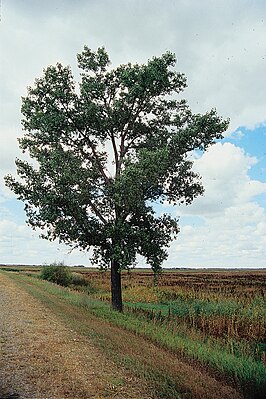Canadian black poplar
| Canadian black poplar | ||||||||||||
|---|---|---|---|---|---|---|---|---|---|---|---|---|

Canadian black poplar ( Populus deltoides ) |
||||||||||||
| Systematics | ||||||||||||
|
||||||||||||
| Scientific name | ||||||||||||
| Populus deltoides | ||||||||||||
| Bartram ex Marshall |
The Canadian black poplar ( Populus deltoides ), also called American black poplar or rosary poplar , is a deciduous tree from the section of the black poplars ( Aigeiros ), which is native to the northern and eastern parts of North America. It is one of the tallest and fastest growing trees east of the Rocky Mountains. Because of the abundance of seed wool, which is similar to cotton, it is called Eastern Cotton Wood in English . After the naturalization in Europe, hybridization with the European black poplar ( Populus nigra ) resulted in the forestry important bastard black poplar ( Populus × canadensis ).
description
The Canadian black poplar is a 30 meter, maximum up to 58 meter high deciduous tree with a continuous trunk and a wide, open crown. It is similar to the European black poplar ( Populus nigra ), but the bark is initially yellowish green and the bark is ash gray. The shoots are generally glabrous and more or less rounded, only the long shoots are angularly ribbed. The buds are resinous, long, pointed, brown in color and have a balsamic scent. The leaves are triangular to broadly ovate , 8 to 12 inches long and pointed, the base is truncated to somewhat heart-shaped. There are two to three glands at the base of the petiole. The leaf margin , ciliate on both sides, is roughly serrated with inwardly curved tips, only the base and tip of the leaf are entire. The upper side of the leaf is glossy dark green, the underside somewhat lighter, both sides are bare. The reddish-tinted petiole becomes 3 to 10 centimeters long. Like all poplars, the Canadian black poplar is dioecious and wind-flowered and forms pendulous catkins . The male catkins are 7 to 10 centimeters long, the single flowers have 40 to 60 stamens . The bracts are slashed farnförmig. The female flowers have three to four styles . The fruits are in 15 to 20 centimeters long catkins. Because of the abundant seed wool that is formed, it is called Eastern Cottonwood in English . The chromosome number for both subspecies is Populus deltoides subsp. monilifera and Populus deltoides subsp. wislizeni 2n = 38.
Distribution and location requirements
The distribution area of the Canadian black poplar extends in the north from southern Québec over southern Ontario west to southern Alberta , in the south to Texas , northwest Florida and Georgia , to the west to the Rocky Mountains. The species was naturalized in Europe.
The Canadian black poplar grows in floodplain and riparian wood, on moderately dry, fresh to moist, slightly acidic to alkaline soils made of sand, gravel and gravel. It loves warmth and prefers sunny locations, but is frost hardy. It is a type of winter hardiness zone 6a, so it can withstand mean annual minimum temperatures of −23 to −21 ° C.
ecology
The Canadian black poplar grows in pure stands or together with various types of willow (genus Salix ), especially with the American black willow ( Salix nigra ) and other deciduous trees such as oak ( Quercus ) and hickory ( Carya ).
Systematics
There are three subspecies:
- Populus deltoides subsp. deltoides : Native to the United States and eastern Canada.
- Populus deltoides subsp. monilifera (Aiton) corner w. (Syn .: Populus deltoides var. Occidentalis Rydb. ): It occurs in Canada and the United States.
- Populus deltoides subsp. wislizeni (S. Watson) corner w. : It occurs in Colorado , Wyoming , New Mexico , Utah , Arizona , Texas and the Mexican state of Chihuahua .
use
→ Main article: Poplar wood
The Canadian black poplar is the most important poplar species in North America in terms of timber. It was seldom used until the turn of the century, only after the decline in the tulip tree population ( liriodendron ) did it gain increasing interest as a replacement. It is sometimes also grown in Central Europe, but hybrids with the European black poplar ( bastard black poplar ) are much more common.
proof
literature
- Andreas Roloff , Andreas Bärtels: Flora of the woods. Purpose, properties and use. With a winter key from Bernd Schulz. 3rd, corrected edition. Eugen Ulmer, Stuttgart (Hohenheim) 2008, ISBN 978-3-8001-5614-6 , p. 464.
- Schütt, Schuck, Stimm: Lexicon of tree and shrub species . Nikol, Hamburg 2002, ISBN 3-933203-53-8 , pp. 395-397 .
Individual evidence
- ↑ Bruno P. Kremer: Trees . In: The colored nature guides . Mosaik, Munich 1984, p. 104 .
- ↑ a b c d e Schütt et al .: Lexicon of tree and shrub species
- ↑ a b c d Roloff et al .: Flora of the Woods
- ↑ Populus deltoides at Tropicos.org. In: IPCN Chromosome Reports . Missouri Botanical Garden, St. Louis
- ↑ a b c d Populus deltoides. Germplasm Resources Information Network (GRIN), accessed December 23, 2016 .

